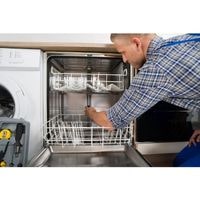Kitchen aid dishwasher leaks. Typically, these dishwashers have no problems keeping all of the water and suds contained within their confines.
So why would a KitchenAid dishwasher be leaking onto your kitchen floor? The most likely reason for a KitchenAid dishwasher to leak is a faulty water inlet valve.
Water could be leaking from the valve itself, or it might be stuck in the ‘open’ position causing an overflow inside.
Damaged seals or gaskets on the diverter motor or around the door could also let water through. The same could also happen from the drain pump or its hose.
Kitchen aid dishwasher leaks

The most likely reason for a KitchenAid dishwasher to leak is a faulty water inlet valve that has its built-in mechanism broken.
Water can then leak into the main unit for your dishwasher through this component, but it may also flow over and cause an overflow inside if stuck in the open position.
Other causes might be lacking necessary seals or gaskets around the door or motor of the diverter.
Kitchenaid dishwashers leak for many reasons, some of which include.
Leaking Drain Pump
A dishwasher’s drain pump is designed to help drain the dishwater out of the appliance.
When something in this part goes wrong, you will then notice that your floor beneath the dishwasher starts to flood with water if you don’t turn off the appliance and try to fix it as soon as possible.
Defective Water Inlet Valve

The water inlet valve opens to let water enter the dishwasher. If it does not close tightly, your dishwasher will continue to fill with water until there is a leak or overflow.
A defective inlet valve’s proper function cannot be restored by repairs it must be replaced.
Damaged Door Gasket
Check to see if the dishwasher closes fully without any gaps between it and the door. If a gap has formed because of damage, determine what caused the damage and fix that part of your dishwasher.
Now check the integrity of your gasket. It is most likely that you need a new sliding door gasket if there is any sort of noticeable damage on either side (top or bottom), as well as gaps in one or more areas. Another common culprit for leaks can be faulty hinges.
Check them to make sure they aren’t bent or broken, and simply replace them with higher quality ones if need be.
Door Seal leaking

Check the seals on your dishwasher. If there is a leak, make sure to repair any torn or missing areas.
You can see if the seals need replacement if you close the dishwasher door and it makes noises or rattles as if some parts of it are loose.
Other signs are that pieces of food will collect around the seal’s edge or a dollar bill will clearly stand out when laid over it.
TIP: When closing the door, don’t hold onto both sides, or you may damage the seal accidentally. Instead, hold onto one side, allowing the seal to close by itself with no help from you.
If the upper wash arm is cracked
If the upper wash arm is cracked, it can cause the dishwasher to spew out water while standing still. Remove the wash arm and inspect it for cracks. If you do find a crack, replace it immediately.
Do not attempt to seal the crack with glue on this dishwasher as that will compromise its ability to effectively clean your dishes properly over time.
An issue with Center Wash Arm Assembly
If the wash arm is damaged or cracked, water may spray toward the door seal, making a leak. Remove the wash arm and inspect it for damaged parts. If the wash arm is damaged, replace it.
Do not seal cracks with glue—the glue will fall apart in your dishwasher. If It’s intact though, make sure that to check screws on it are working properly and as well tighten them in case you find any loose ones.
This way you can avoid water from spraying into the under-pump area and causing waves to break down because of possible leakage in case the washer isn’t pretty tight with its fixed bottom part.
Problem with Lower Wash Arm Assembly
If the arm isn’t washed enough, it can spray directly to the bottom of the dishwasher door. This water can then get under the door and onto the floor, causing a leak. Check for cracks in the arm.
If the arms are cracked, you’ll have to replace it, but if it’s in one piece but not cleaned all that often, check those screws again, that should be tight enough to avoid any leaks.
You might use some glue at this point because of any little crack left but don’t do so if there is no crack or slight one as the glue will eventually break and make things even worse check for waves carefully as they may get out of hand as well and cause your whole dishwasher weak and thus leaky.
Kitchen aid dishwasher leaks
Related Guides
